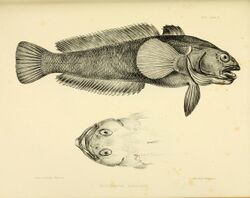Biology:Notothenia coriiceps
| Notothenia coriiceps | |
|---|---|

| |
| Biodiversity Heritage Library | |
| Scientific classification | |
| Domain: | Eukaryota |
| Kingdom: | Animalia |
| Phylum: | Chordata |
| Class: | Actinopterygii |
| Order: | Perciformes |
| Family: | Nototheniidae |
| Genus: | Notothenia |
| Species: | N. coriiceps
|
| Binomial name | |
| Notothenia coriiceps J. Richardson, 1844
| |
Notothenia coriiceps, also known as the black rockcod, Antarctic yellowbelly rockcod, or Antarctic bullhead notothen, is a species of notothen that is widely spread around the Antarctic continent.[1] Like other Antarctic notothenioid fishes, N. coriiceps evolved in the stable, ice-cold environment of the Southern Ocean.[2] It is not currently targeted by commercial fisheries.[3]
Distribution and diet
N. coriiceps maintains a circum-Antarctic distribution that is likely governed at least in part by the presence of the Antarctic Circumpolar Current (ACC) as well as its egg dispersal patterns.[1] Populations of this species have been recorded at sites in the western Ross Sea, the Weddell Sea, the Western Antarctic Peninsula, the islands of the Scotia Arc to South Georgia, the Balleny Islands, and the sub-Antarctic islands of the Indian Ocean sector.[4] N. coriiceps feeds on macroalgae[5] amphipods[5] and euphausiids.[6] It appears to feed year-round, although diet composition likely varies seasonally.[5]
Morphology
N. coriiceps members have scales that typically appear brown or gray in color. Its teeth consist of a multi-row tooth plate and caniform teeth, which are located in the outer portion of the jaw.[7] Adults males typically reach a length of approximately 50 cm (20 in).[8]
Like many other notothenioid fishes, it lacks a swim bladder.[1] Bone density increases during maturation, resulting in reduced buoyancy and the transition from pelagic to desmersal swimming behavior.[9] Adults N. coriiceps possess a dense, well-developed skeleton compared to its congener Notothenia rossii, accounting for its reduced buoyancy.[10]
Its epithelium is characterized by the presence of fat droplets, which serve as a storage mechanism for dietary lipids.[11] Fat droplets are also stored in bone tissue.[9]
Physiology
Like most other Antarctic notothenioids, N. coriiceps exhibits several adaptations that optimize organismal performance at subzero temperatures.[2] These include a modified heat shock response,[2] the production of antifreeze glycoproteins that prevent ice crystallization of body fluids at subzero temperatures,[12] and the abundance of polyunsaturated fatty acids that allow cells to maintain membrane fluidity.[13] N. coriiceps has an limited tolerance for acute temperature change but has demonstrated the capacity to extend its thermal limits upon long-term acclimation to warmer temperatures.[14][15]
Genome
The N. coriiceps genome was sequenced in 2014.[2] Results indicated rapid evolution of genes during speciation, especially in proteins that code for mitochondrial proteins and hemoglobin. In addition, the authors found that many N. coriiceps genes are reflective of adaptation to cold temperatures, with specialized genes related to the species' modified heat shock response as well as enhanced oxidative phosphorylation at cold temperatures.
References
- ↑ 1.0 1.1 1.2 Eastman, Joseph (1993). Antarctic Fish Biology: Evolution in a Unique Environment. San Diego, California: Academic Press, In
- ↑ 2.0 2.1 2.2 2.3 Shin, SC (2014). "The genome sequence of the Antarctic bullhead notothen reveals evolutionary adaptations to a cold environment". Genome Biology 15 (9): 468. doi:10.1186/s13059-014-0468-1. PMID 25252967.
- ↑ Barrera-Oro, E.R.; Marschoff, E. (2007). "Information on the status of fjord Notothenia rossii, Gobionotothen gibberifrons and Notothenia coriiceps in the lower South Shetland Islands, derived from the 2000-2006 monitoring program at Potter Cove". CCAMLR Science Journal of the Scientific Committee and the Commission for the Conservation of Antarctic Marine Living Resource 14: 83–87. https://www.researchgate.net/publication/242287506.
- ↑ "Notothenia coriiceps Richardson, 1844 Black rockcod". http://fishbase.org/summary/Notothenia-coriiceps.html.
- ↑ 5.0 5.1 5.2 Iken, K (1997). "Grazing by the Antarctic fish Notofhenia coriiceps: evidence for selective feeding on macroalgae". Antarctic Science 9 (4): 386–391. doi:10.1017/S0954102097000497. Bibcode: 1997AntSc...9..386I. https://epic.awi.de/id/eprint/1484/1/Iken97_AntSci9.pdf.
- ↑ Coggan, Roger (1997). "Seasonal and annual growth rates in the Antarctic fish Notothenia coriiceps Richardson". Journal of Experimental Marine Biology and Ecology 213 (2): 215–229. doi:10.1016/S0022-0981(96)02731-1.
- ↑ Voskoboynicova, OS (1993). "Evolution of visceral skeleton and phylogeny of Nototheniidae". Journal of Ichthyology 33: 23–47. https://www.researchgate.net/publication/271210818.
- ↑ Dewitt, H.H.; Heemstra, P.C.; Gon, O. (1990). Fishes of the Southern Ocean. Grahamstown, South Africa: Smith Institute of Ichthyology.
- ↑ 9.0 9.1 Eastman, JT (2014). "Divergence in Skeletal Mass and Bone Morphology in Antarctic Notothenioid Fishes". Journal of Morphology 275 (8): 841–861. doi:10.1002/jmor.20258. PMID 24590921.
- ↑ Eastman, JT (2011). "Adaptive radiation at a low taxonomic level: divergence in buoyancy of the ecologically similar Antarctic fish Notothenia coriiceps and N. rossii". Marine Ecology Progress Series 438: 195–206. doi:10.3354/meps09287. Bibcode: 2011MEPS..438..195E. https://www.int-res.com/articles/meps2011/438/m438p195.pdf.
- ↑ Hernandez-Blazquez, FJ (2006). "Fat absorptive processes in the intestine of the Antarctic fish Notothenia coriiceps (Richardson, 1844)". Polar Biology 29 (10): 831–836. doi:10.1007/s00300-006-0121-x.
- ↑ Chen, L (1997). "Evolution of antifreeze glycoprotein gene from a trypsinogen gene in Antarctic notothenioid fish". PNAS 94 (8): 3811–3816. doi:10.1073/pnas.94.8.3811. PMID 9108060. Bibcode: 1997PNAS...94.3811C.
- ↑ Magalhães BS (2010). "Comparison of fatty acid composition in nine organs of the sympatric Antarctic teleost fish species Notothenia coriiceps and Notothenia rossii (Perciformes: Nototheniidae)". Comparative Biochemistry and Physiology B 155 (2): 132–137. doi:10.1016/j.cbpb.2009.10.012. PMID 19883785. https://repositorio.ucb.br:9443/jspui/handle/123456789/7863.
- ↑ Bilyk (2012). "Heat hardening in Antarctic notothenioid fishes". Polar Biology 35 (9): 1447–1451. doi:10.1007/s00300-012-1189-0.
- ↑ Joyce, William; Axelsson, Michael; Egginton, Stuart; Farrell, Anthony P; Crockett, Elizabeth L; O’Brien, Kristin M; Fangue, Dr. Nann (2018). "The effects of thermal acclimation on cardio-respiratory performance in an Antarctic fish (Notothenia coriiceps)". Conservation Physiology 6 (1): coy069. doi:10.1093/conphys/coy069. PMID 30568798.
Wikidata ☰ Q1912723 entry

